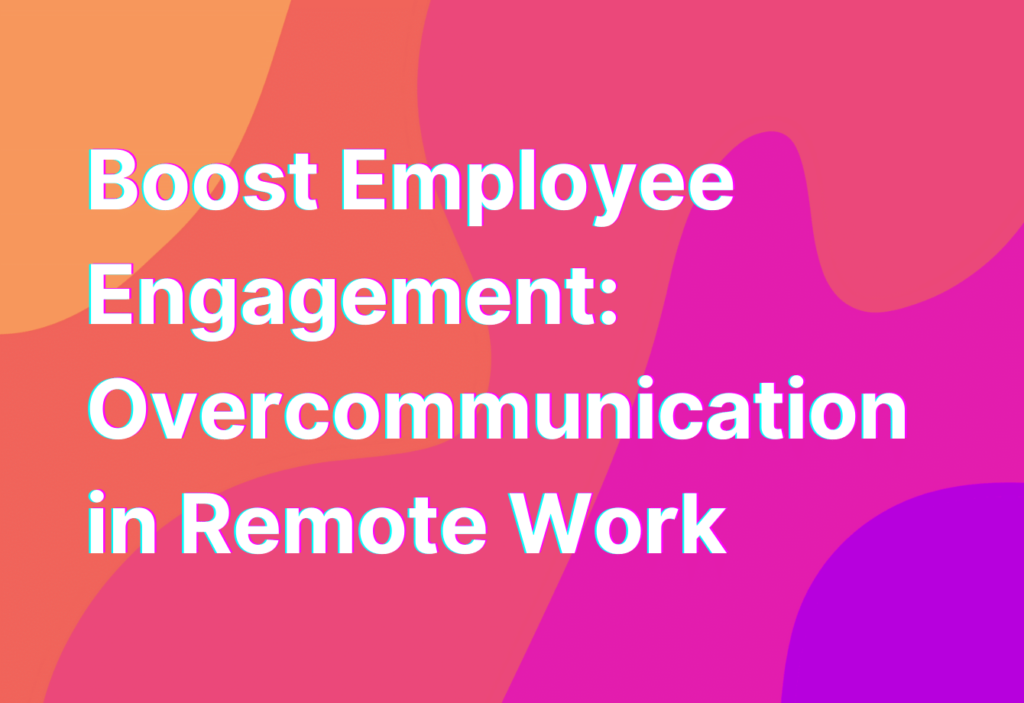Boost Employee Engagement: Overcommunication in Remote Work
Hey there, remote work enthusiasts! It’s Ashley here, your friendly remote work advocate with 10 years of experience in the tech industry. Today, I want to talk about a topic that is near and dear to my heart: overcommunication in remote work. Now, I know what you’re thinking – “Ashley, isn’t overcommunication a bad thing?” Well, my friend, not in the world of remote work. In fact, overcommunication can be the secret sauce to boosting employee engagement and creating a thriving remote team. So, let’s dive in and explore why overcommunication is so important in the remote work landscape.
The Power of Overcommunication
When you’re working remotely, it’s easy to feel disconnected from your team. You don’t have those casual watercooler conversations or impromptu brainstorming sessions that happen in a traditional office setting. That’s where overcommunication comes in. By intentionally overcommunicating, you can bridge the gap and create a sense of connection and collaboration within your remote team.
Overcommunication doesn’t mean bombarding your team with unnecessary emails or scheduling endless video meetings. It’s about finding the right balance and using various communication channels to keep everyone in the loop. Let’s explore some practical ways to implement overcommunication in your remote work setup.
1. Embrace the Power of Video
Video calls are a remote worker’s best friend. They allow you to see your colleagues’ facial expressions, hear their tone of voice, and pick up on non-verbal cues. This level of communication is invaluable when you’re working remotely. So, instead of relying solely on emails or instant messaging, make it a point to schedule regular video calls with your team.
Pro tip: Use tools like Zoom or Google Meet to host virtual meetings. These platforms offer features like screen sharing and breakout rooms, making collaboration a breeze.
2. Leverage Chat and Collaboration Tools
When you’re not able to have face-to-face interactions, chat and collaboration tools become your lifeline. Platforms like Slack, Microsoft Teams, and Trello allow you to have real-time conversations, share files, and collaborate on projects seamlessly.
Pro tip: Create dedicated channels or groups for different teams or projects to keep conversations organized and easily accessible.
3. Set Clear Expectations
One of the challenges of remote work is the lack of visibility into what your colleagues are working on. To overcome this, it’s crucial to set clear expectations and communicate them effectively. Make sure everyone on your team knows what their responsibilities are, what the deadlines are, and how their work contributes to the overall goals of the company.
Pro tip: Use project management tools like Asana or Monday.com to assign tasks, set deadlines, and track progress.
4. Foster a Culture of Feedback
Feedback is essential for growth and improvement, both individually and as a team. In a remote work environment, it’s even more important to actively seek and provide feedback. Encourage your team members to share their thoughts, ideas, and concerns openly. Create a safe space where everyone feels comfortable giving and receiving feedback.
Pro tip: Check out this article on psychological safety in remote work to learn more about creating an environment that fosters open communication and trust.
5. Celebrate Wins and Milestones
Working remotely can sometimes feel isolating, especially when you don’t have your team physically present to celebrate achievements. That’s why it’s important to make a conscious effort to acknowledge and celebrate wins and milestones, big or small. Whether it’s a virtual happy hour, a shoutout in the team chat, or a handwritten note, find ways to show appreciation and boost morale.
Pro tip: Use tools like Bonusly or Kudos to give virtual recognition and rewards to your team members.
Wrapping Up
Overcommunication may seem counterintuitive, but in the world of remote work, it’s a game-changer. By intentionally overcommunicating, you can foster a sense of connection, collaboration, and engagement within your remote team. Embrace the power of video, leverage chat and collaboration tools, set clear expectations, foster a culture of feedback, and celebrate wins and milestones. Trust me, your remote team will thank you for it!


